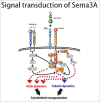Regulation of dendritic development by semaphorin 3A through novel intracellular remote signaling
- PMID: 27392015
- PMCID: PMC5160031
- DOI: 10.1080/19336918.2016.1210758
Regulation of dendritic development by semaphorin 3A through novel intracellular remote signaling
Abstract
Numerous cell adhesion molecules, extracellular matrix proteins and axon guidance molecules participate in neuronal network formation through local effects at axo-dendritic, axo-axonic or dendro-dendritic contact sites. In contrast, neurotrophins and their receptors play crucial roles in neural wiring by sending retrograde signals to remote cell bodies. Semaphorin 3A (Sema3A), a prototype of secreted type 3 semaphorins, is implicated in axon repulsion, dendritic branching and synapse formation via binding protein neuropilin-1 (NRP1) and the signal transducing protein PlexinAs (PlexAs) complex. This review focuses on Sema3A retrograde signaling that regulates dendritic localization of AMPA-type glutamate receptor GluA2 and dendritic patterning. This signaling is elicited by activation of NRP1 in growth cones and is propagated to cell bodies by dynein-dependent retrograde axonal transport of PlexAs. It also requires interaction between PlexAs and a high-affinity receptor for nerve growth factor, toropomyosin receptor kinase A. We propose a control mechanism by which retrograde Sema3A signaling regulates the glutamate receptor localization through trafficking of cis-interacting PlexAs with GluA2 along dendrites; this remote signaling may be an alternative mechanism to local adhesive contacts for neural network formation.
Keywords: CRMPs; axonal transport; dendritic branching; neurotrophins; semaphorins; spine maturation.
Figures



Similar articles
-
TrkA mediates retrograde semaphorin 3A signaling through plexin A4 to regulate dendritic branching.J Cell Sci. 2016 May 1;129(9):1802-14. doi: 10.1242/jcs.184580. Epub 2016 Mar 4. J Cell Sci. 2016. PMID: 26945060
-
Plexin-A4-dependent retrograde semaphorin 3A signalling regulates the dendritic localization of GluA2-containing AMPA receptors.Nat Commun. 2014 Mar 6;5:3424. doi: 10.1038/ncomms4424. Nat Commun. 2014. PMID: 24599038
-
Voltage-gated calcium and sodium channels mediate Sema3A retrograde signaling that regulates dendritic development.Brain Res. 2016 Jan 15;1631:127-36. doi: 10.1016/j.brainres.2015.11.034. Epub 2015 Nov 27. Brain Res. 2016. PMID: 26638837
-
Retrograde signaling via axonal transport through signaling endosomes.J Pharmacol Sci. 2019 Oct;141(2):91-96. doi: 10.1016/j.jphs.2019.10.001. Epub 2019 Oct 17. J Pharmacol Sci. 2019. PMID: 31679963 Review.
-
Knowing how to navigate: mechanisms of semaphorin signaling in the nervous system.Sci STKE. 2002 Feb 12;2002(119):re1. doi: 10.1126/stke.2002.119.re1. Sci STKE. 2002. PMID: 11842242 Review.
Cited by
-
MicroRNA-30b regulates the polarity of retinal ganglion cells by inhibiting semaphorin-3A.Mol Vis. 2019 Nov 14;25:722-730. eCollection 2019. Mol Vis. 2019. PMID: 31814697 Free PMC article.
-
Microtubule Dynamics, Kinesin-1 Sliding, and Dynein Action Drive Growth of Cell Processes.Biophys J. 2018 Oct 16;115(8):1614-1624. doi: 10.1016/j.bpj.2018.08.046. Epub 2018 Sep 11. Biophys J. 2018. PMID: 30268540 Free PMC article.
-
Extrinsic Factors Regulating Dendritic Patterning.Front Cell Neurosci. 2021 Jan 13;14:622808. doi: 10.3389/fncel.2020.622808. eCollection 2020. Front Cell Neurosci. 2021. PMID: 33519386 Free PMC article. Review.
-
p39-associated Cdk5 activity regulates dendritic morphogenesis.Sci Rep. 2020 Oct 30;10(1):18746. doi: 10.1038/s41598-020-75264-6. Sci Rep. 2020. PMID: 33127972 Free PMC article.
-
Whole-Exome Sequencing Identified Rare Genetic Variants Associated with Undervirilized Genitalia in Taiwanese Pediatric Patients.Biomedicines. 2023 Jan 17;11(2):242. doi: 10.3390/biomedicines11020242. Biomedicines. 2023. PMID: 36830778 Free PMC article.
References
-
- Shen K, Cowan CW. Guidance molecules in synapse formation and plasticity. Cold Spring Harb Perspect Biol 2010; 2:a001842; PMID:20452946; http://dx.doi.org/10.1101/2shperspect.a001842 - DOI - PMC - PubMed
-
- Colon-Ramos DA, Margeta MA, Shen K. Glia promote local synaptogenesis through UNC-6 (netrin) signaling in C. elegans. Science 2007; 318:103-6; PMID:17916735; http://dx.doi.org/10.1126/2cience.1143762 - DOI - PMC - PubMed
-
- Santiago C, Bashaw GJ. Transcription factors and effectors that regulate neuronal morphology. Development 2014; 141:4667-80; PMID:25468936; http://dx.doi.org/10.1242/2ev.110817 - DOI - PMC - PubMed
-
- Tessier-Lavigne M, Goodman CS. The molecular biology of axon guidance. Science 1996; 274:1123-33; PMID:8895455; http://dx.doi.org/10.1126/2cience.274.5290.1123 - DOI - PubMed
-
- Ju W, Morishita W, Tsui J, Gaietta G, Deerinck TJ, Adams SR, Garner CC, Tsien RY, Ellisman MH, Malenka RC. Activity-dependent regulation of dendritic synthesis and trafficking of AMPA receptors. Nat Neurosci 2004; 7:244-53; PMID:14770185; http://dx.doi.org/10.1038/2n1189 - DOI - PubMed
Publication types
MeSH terms
Substances
LinkOut - more resources
Full Text Sources
Other Literature Sources
Miscellaneous
